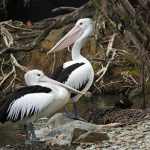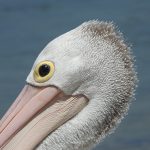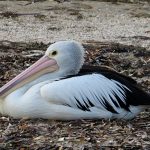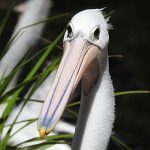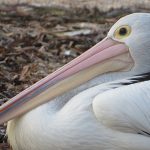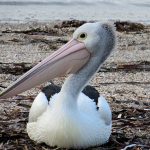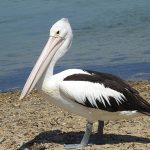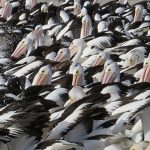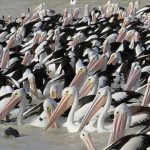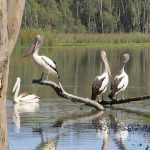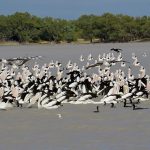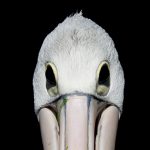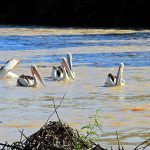PELICAN
(Pelecanus conspicillatus)
Sharon : I heard via the Grapevine that the Pelicans had arrived at Menindee Lakes in NSW, Australia, after recent flooding rains. Water levels had risen in the Darling River and the Lakes were now filling. Flood gates were opened allowing the passage of fish along with the flood waters. As we were travelling through the area at that time we decided to make a detour to the Lakes, and we were not disappointed with the decision. 100’s of Pelicans had gathered along with 100’s of Little Black Cormorants. It was a wonderful ‘Close Encounter’ as we watched this Pelican Event.
The Australian Pelican: The Giant of Australia’s Waterways
Imagine standing by a shimmering Australian lake at dawn, the air cool and tinged with the earthy scent of wetland plants. Suddenly, a sweeping shadow passes overhead—a bird with wings so vast it could blanket the early morning sun. This is the Australian Pelican , a remarkable and adaptable resident of Australia’s diverse aquatic landscapes.
Physical Description
With a wingspan stretching up to 2.5 metres, the Australian Pelican is one of the largest flying birds on the continent. Its plumage is a striking combination of crisp white feathers contrasted by bold black wingtips. The most eye-catching feature, however, is its long, pinkish bill, complete with a flexible pouch. This pouch can expand dramatically, resembling a living net, ready to scoop up shimmering fish from the water’s surface.
| Feature | Description |
|---|---|
| Wingspan | Up to 2.5 metres |
| Plumage | White with black wingtips |
| Bill | Long, pinkish, with expandable throat pouch |
| Lifespan | 10–25 years or more |
Habitat and Range
Australian Pelicans are true wanderers. Their adaptability allows them to thrive in a range of environments:
- Coastal regions: From sandy beaches to rocky inlets, they soar above the surf or rest on sunlit rocks.
- Inland lakes and rivers: During times of flooding, pelicans venture far into the arid heart of Australia, finding temporary oases where life flourishes.
- Wetlands and estuaries: Among reeds and water lilies, their presence brings life to quiet backwaters.
Their haunting, echoing calls often mingle with the gentle slap of water and the distant chorus of frogs and insects.
Feeding Behaviour
The feeding habits of Australian Pelicans are a spectacle to observe:
- Cooperative hunting: Sometimes, groups of pelicans work together, herding schools of fish toward the shallows.
- Solo fishing: With a sudden plunge, the pelican’s bill slices into the water, its pouch filling with fish and cool, fresh water.
- Diet variety: Beyond fish, they occasionally feast on crustaceans and even small birds, demonstrating a remarkable adaptability in their diet.
As they feed, you might hear the gentle splash of water, the flapping of wings, and the rhythmic clatter of their bills against the surface.
Breeding and Life Cycle
Australian Pelicans are social birds, often forming large breeding colonies on remote islands or within protected wetlands.
- Nest building: Shallow nests are constructed from sticks and vegetation, nestled close to water.
- Shared duties: Both parents incubate the eggs and feed the chicks.
- Chick development: Hatchlings are covered in soft, greyish-brown down, gradually moulting into the iconic white adult plumage.
The air around a nesting colony hums with the sound of hungry chicks and the constant movement of attentive parents.
Relationship with Humans
Australian Pelicans are a familiar sight even in urban areas and popular tourist destinations. Their graceful flight, often in elegant formation, and their charismatic presence have made them icons of Australia’s natural heritage.
- Tourism: Their image frequently appears in tourism campaigns, symbolising the wild beauty of Australia’s coasts and wetlands.
- Observation: Birdwatchers and nature lovers delight in their antics, whether gliding above the surf or resting serenely beside riverbanks.
Conservation Message
Wetlands and waterways are the lifeblood of the Australian Pelican. As these habitats face pressures from development, pollution, and climate change, the future of pelicans—and countless other species—depends on our actions.
Protecting wetlands not only preserves these magnificent birds but also ensures clean water, flood control, and rich biodiversity for generations to come.
The Australian Pelican, with its majestic wings and gentle, inquisitive nature, is a living emblem of Australia’s wild places. Next time you encounter one, take a moment to watch its elegant movements, listen to the sounds of its world, and remember the vital role it plays in the intricate tapestry of life.
Let’s cherish and protect these remarkable birds and the habitats they call home.
Would you like to hear a story about an Australian Pelican’s journey across the outback, or learn about how to spot one in the wild?
Photo Gallery
Sharon tells the story: Travelling up the Stuart Highway in Central Australia we stopped off at a large Lagoon to camp for the night. What we saw was one of those unforgettable wildlife moments. There were 100’s of Pelicans and 1000’s of Little Black Cormorants flying in and settling on the lagoon. More and more birds kept flying in with some settling on the lagoon’s riverbanks. Then they began swimming together, herding the fish to an area where they were easier to catch. Even some Spoonbills joined the ‘Feeding Frenzie’. See if this ‘Close Encounter’ amazes you as much as it did us.

